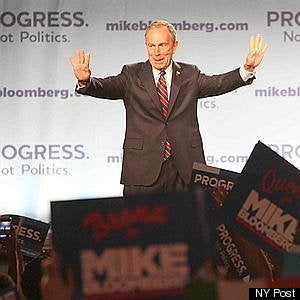
Rudy Giuliani was once in a hilarious Saturday Night Live skit where he donned a wig and a housecoat and adopted the pronounced honk of an exaggerated outer borough accent. What made the skit perfect was that Giuliani was gently poking fun at his kind of people: the working class, outer-borough white ethnics who overwhelmingly voted for him in three mayoral elections.
Giuliani's successor, while also a Republican, has been harder to characterize. Compared to the Brooklyn-bred, "Go Yankees!" Giuliani, Mike Bloomberg—a wealthy transplant from Boston—has always seemed like the kind of candidate whose base would sip Perrier rather than Pabst (if you'll forgive me for reducing people to the crudest of stereotypes).
Broadly speaking, that impression is accurate. The support of wealthy elites has been vital to Bloomberg's political career, from the acquiescence of hoity-toity good government types like the Times editorial board toward his mind-blowing campaign spending in 2005 to the cheerleading by the upper crust, including Steve Rattner and Henry Kissinger, for a term limits overhaul last year.
But for all their influence, wealthy people don't actually vote more than the rabble. In fact many of Bloomberg's supporters this year, like Colin Powell and the president of the Dominican Republic, are unlikely to vote for him at all because—what do you know?—they don't live in New York City! So where do Bloomberg's votes come from? If Giuliani's heartland wore housecoats, what does Bloomberg country look like?
An analysis of 2005 general election returns by assembly district reveals an interesting fact: While the mayor prevailed by comfortable margins in many districts and by landslide proportions in several, his most lopsided win was not—as one might expect—on the Upper East Side, New York's wealthiest area and hizzoner's own hood.
He did fabulously well there, in Jonathan Bing's 73rd Assembly district, nabbing 86.6 percent of the vote against Freddy Ferrer. But Bloomberg did a hair better—getting 86.8 percent of the vote—in the 48th assembly district, in Borough Park, Brooklyn, where conservative Democrat Dov Hikind holds the legislative seat.
Detailed election results from 1997 are no longer available online, so we can't compare Bloomberg's heartland to Giuliani's. But we can suspect that there's a substantial and somewhat surprising overlap between the two candidates' bases.
That doesn't, of course, answer the longstanding question about whether the people who vote for Bloomberg love him even half as much as Rudy's supporters loved their man; not that Bloomberg's opponents are nearly as passionate as Rudy's were, either. And who knows if it's relevant to the question of whether, eight years into putting his own stamp on city policies, Bloomberg really deserves as much credit as he gets for being a better mayor than Giuliani.
But what it does suggest is that outer borough whites, who were key to electing Ed Koch three times and Giuliani twice, were crucial to Bloomberg, too, even if this mayor has also attracted significant support from blacks and Latinos.
Where's Bill Thompson country? The two-term comptroller and Democratic nominee hasn't faced a competitive election since the 2001 comptroller primary, when he bested City Councilman Herb Berman after a bitter fight. Thompson's best showing in that contest was in the 56th, a Bed-Stuy assembly district represented by Annette Robinson, a liberal Democrat. Thompson received 82 percent of the vote there.
Yes, the main vein of both Bloomberg and Thompson's past electoral support is in Kings County. But the similarities end there. Hikind's and Robinson's district offices are only about four miles apart as the crow flies, but those four miles cover an expanse of social and political distance.
Judging by the demographic profiles of the community districts that overlap with the bulk of each assembly district, Robinson's is overwhelmingly black and has a median household income of around $31,000. In Hikind's area, the median income is only slightly higher—$38,000—but the population is overwhelmingly white. The 2006 infant mortality rate in Robinson-land was 9.1; in Hikind-ville, it was 1.2. In the 2008 presidential election, 99.2 percent of voters in Robinson's district voted for Barack Obama. Hikind's district went 71 percent for John McCain.
Interestingly, in this year's Democratic mayoral primary, Thompson won 2,020 votes in Hikind's district. That's more than three times as many votes as Ferrer won there in the primary four years ago, when Anthony Weiner and Gifford Miller placed first and second in the district ahead of Ferrer, and turnout was 20 percent higher. Despite being a better racial and religious fit with the district, Weiner's total in 2005 was only 77 votes higher than Thompson's this year.
Is that comparison akin to comparing deck chairs on the Titanic to those on the Andrea Doria?
Or does that mean there's trouble in Bloomberg-burgh?
Button your housecoats and hang on!